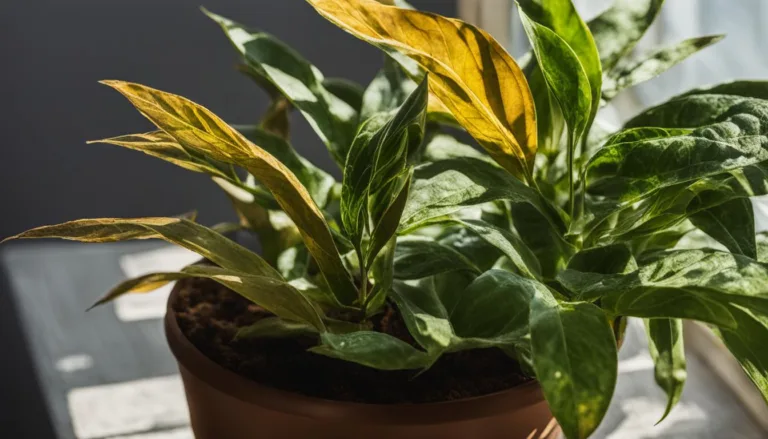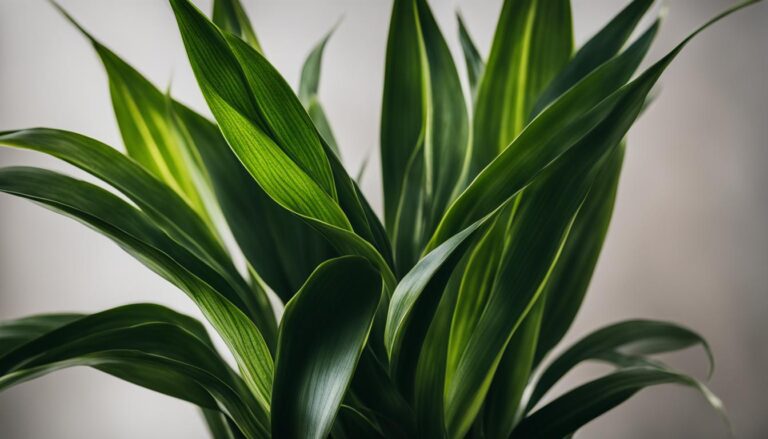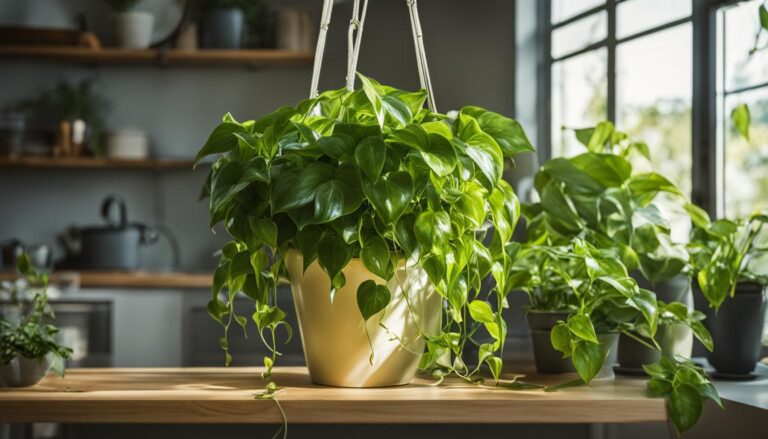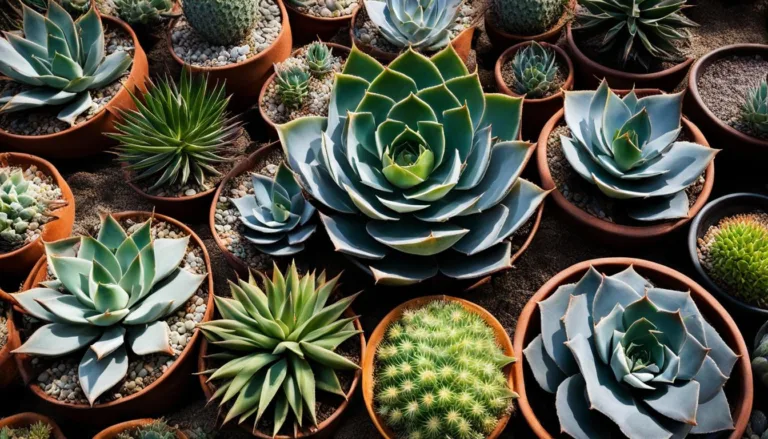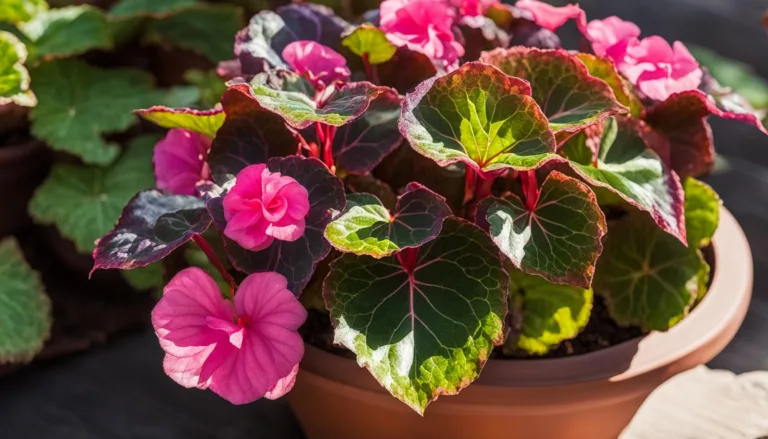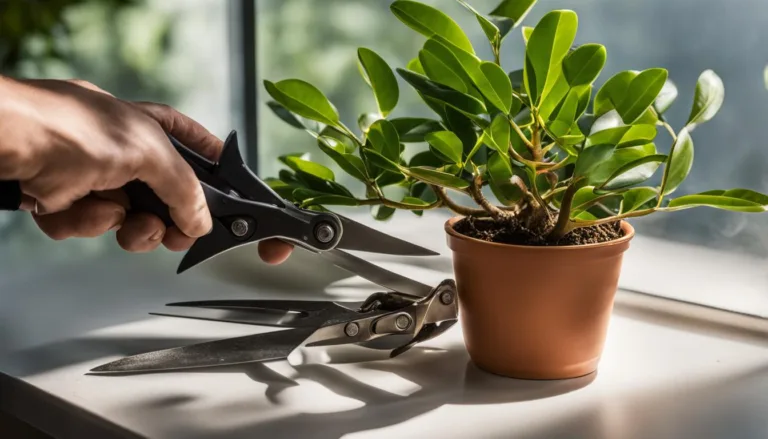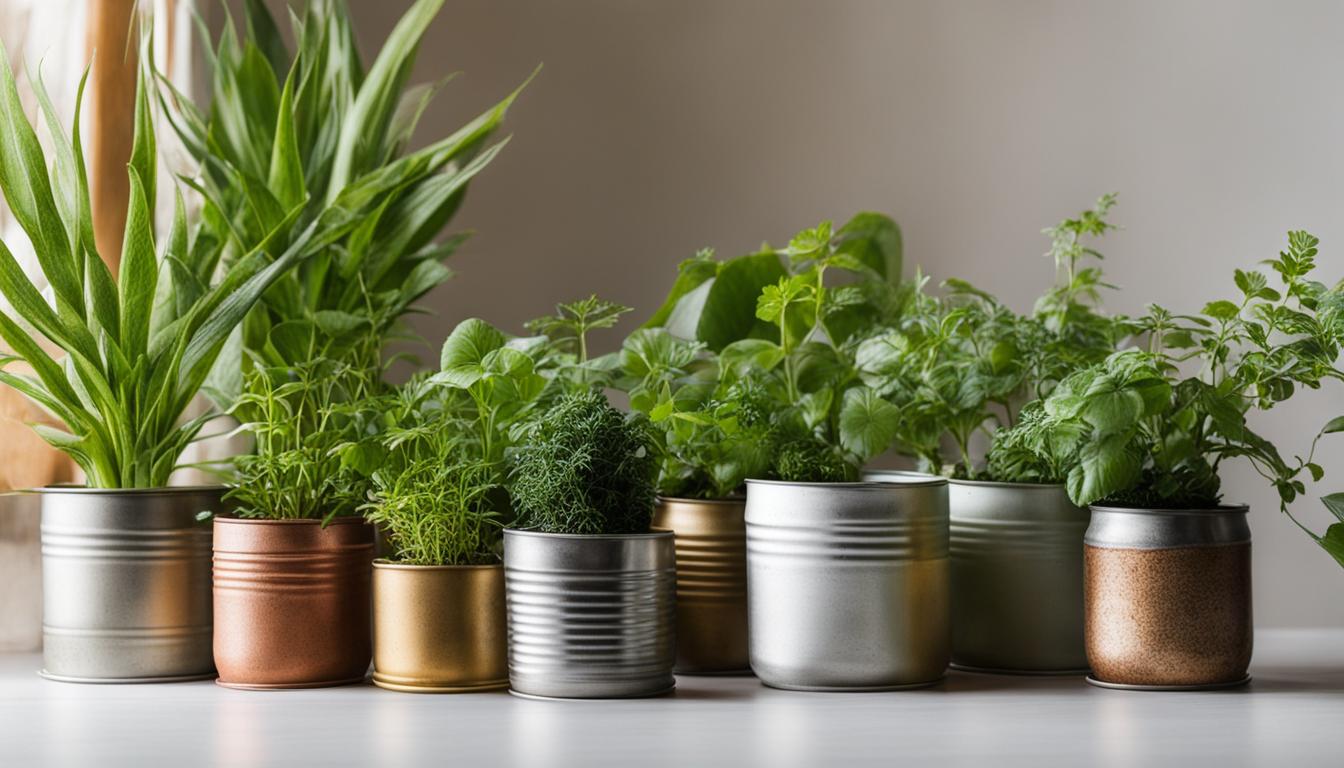
Indoor plant care can be done in a zero waste and sustainable manner. By implementing eco-friendly practices and waste reduction techniques, you can nurture your indoor plants while minimizing your impact on the environment.
In this article, I will explore some zero waste approaches to caring for indoor plants, providing you with green gardening tips and sustainable plant care practices.
Key Takeaways:
- Zero waste approaches in indoor plant care can help minimize your environmental impact.
- Reusing containers for repotting and regularly removing dead leaves are effective waste reduction techniques.
- Soap spray, neem oil, and pepper spray can be used as eco-friendly bug control methods.
- Banana tea, tea leaves, and Epsom salt can serve as natural fertilizers for your indoor plants.
- Collecting rainwater and reusing cooking water are sustainable watering options.
Reusing Containers for Repotting
To practice zero waste gardening and promote sustainable plant care, one effective approach is reusing containers for repotting indoor plants. Instead of buying new pots and plastic containers, I recommend saving and cleaning old ones to use when your plants need to be replanted.
By reusing containers, you can minimize waste and reduce the need for new gardening supplies, making it an eco-friendly and cost-effective choice.
When selecting containers, make sure they are clean and free from any contaminants that could harm your plants. You can wash them with warm, soapy water and rinse thoroughly before use.
It’s important to ensure that the containers have proper drainage holes to prevent waterlogging and root rot. You can also create drainage by placing small rocks or broken pottery pieces at the bottom of the containers.
Reusing containers not only benefits the environment but also allows you to get creative with your indoor garden. You can decorate and personalize the containers to match your aesthetic preferences, adding a touch of uniqueness to your plant display.
Remember to choose containers that are appropriately sized for your plants, providing enough space for their roots to grow and thrive.
Benefits of Reusing Containers for Repotting
- Reduces waste and contributes to a zero waste gardening approach
- Saves money by eliminating the need to purchase new pots and containers
- Allows for creativity in personalizing and decorating containers
- Supports sustainable plant care practices and eco-friendly gardening
- Provides proper drainage for healthy plant growth
- Minimizes the use of plastic and other non-biodegradable materials
| Container Type | Pros | Cons |
|---|---|---|
| Terra cotta pots | Durable, breathable, and aesthetically pleasing | Can be heavy and prone to breakage |
| Plastic containers | Lightweight, easy to clean, and come in various sizes | Not biodegradable and may leach chemicals over time |
| Glass jars | Recyclable, transparent, and can be repurposed for terrariums | May have limited drainage options |
By reusing containers for repotting, you can contribute to a more sustainable and eco-friendly approach to indoor plant care. Not only will you reduce waste, but you will also save money and have the opportunity to get creative with your plant display.
So before throwing away those old containers, consider giving them a second life by repurposing them for your indoor garden.
Regular Removal of Dead Leaves
Regularly removing dead leaves from your indoor plants is an essential zero waste approach to plant care. By cutting off dead leaves with scissors instead of pulling them away, you can help your plants focus their energy on maintaining healthy foliage.
Removing dead fallen leaves prevents them from rotting in the pot and allows for proper composting with food scraps, minimizing waste.
Not only does the removal of dead leaves contribute to waste reduction, but it also helps maintain the overall aesthetic appeal of your plants.
Dead leaves can detract from the beauty of your indoor garden, so regularly removing them ensures that your plants always look their best.
To make the process more efficient, inspect your plants regularly and remove any dead leaves as soon as you spot them.
This proactive approach to plant care not only minimizes waste but also helps prevent the spread of diseases or pests that may be associated with decaying foliage. By staying on top of dead leaf removal, you can keep your plants healthy, vibrant, and waste-free.
- Regularly removing dead leaves from indoor plants is a zero waste approach to plant care.
- Removing dead leaves helps plants focus on healthy foliage and prevents rotting and waste accumulation.
- Proactively inspect and remove dead leaves to maintain the aesthetic appeal and overall health of your indoor plants.
Soap Spray for Bug Control
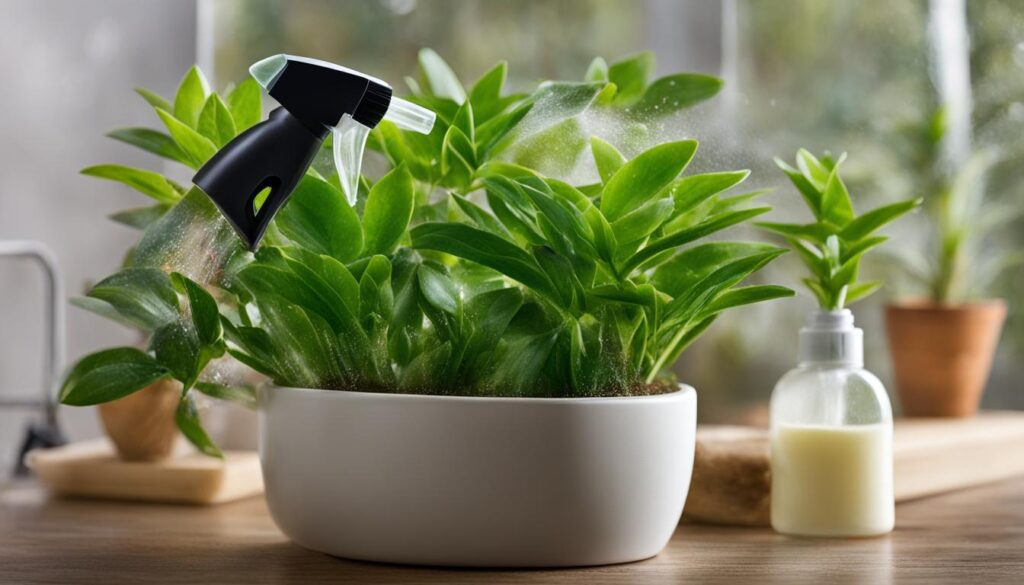
When it comes to natural pest control in your indoor plants, a soap spray can be a highly effective and eco-friendly solution. This zero waste approach utilizes simple ingredients to create a powerful bug repellent.
To make a soap spray, mix 1 teaspoon of mild soap, such as Castile soap, with 2 cups of water. Stir the mixture well to ensure the soap is thoroughly dissolved. Then, pour the soap spray into a clean spray bottle for easy application.
Soap spray is a versatile bug control method that can help eliminate common pests such as beetles, whiteflies, mites, and aphids. When you encounter these unwelcome visitors on your indoor plants, simply spray the solution directly onto the affected leaves and stems.
Be sure to cover both sides of the leaves to ensure thorough treatment. Repeat this process once a week to maintain the effectiveness of the soap spray.
Using soap spray for bug control is not only effective but also sustainable. It reduces the need for harmful chemical pesticides, promoting a greener and more eco-friendly gardening routine.
To further minimize waste, consider purchasing soap in bulk or from zero waste shops that offer liquid soap refills. By adopting a zero waste approach to bug control, you can protect your indoor plants while minimizing your environmental impact.
Table: Common Pests Controlled by Soap Spray
| Pest | Description |
|---|---|
| Beetles | Common plant pests that feed on leaves and can cause significant damage. |
| Whiteflies | Small, flying insects that suck sap from plant leaves, causing wilting and yellowing. |
| Mites | Microscopic pests that infest plant leaves and cause discoloration, webbing, and stunted growth. |
| Aphids | Soft-bodied insects that suck sap from plant stems and leaves, leading to curling, yellowing, and stunted growth. |
Neem Oil for Bug Control
When it comes to natural pest control in indoor plants, neem oil is a zero waste and eco-friendly option. Derived from the seeds of the neem tree, this natural remedy is biodegradable, non-toxic to pets, and effective against many common insects. Using neem oil helps maintain a sustainable plant care routine while minimizing the use of synthetic pesticides.
To make a neem oil spray, combine 2 teaspoons of neem oil, 1 teaspoon of mild liquid soap, and 2 cups of water. Mix the ingredients thoroughly and transfer the solution to a spray bottle.
When your plants are infested with pests or to prevent bug infestations, spray the mixture on the foliage, including the undersides of leaves. This will help eliminate pests and protect your indoor plants.
Benefits of Neem Oil:
- Effective against common indoor plant pests like aphids, mites, whiteflies, and beetles.
- Environmentally friendly and biodegradable.
- Non-toxic to pets and beneficial insects.
- Can be used as a preventative measure or to treat existing infestations.
- Minimizes the use of synthetic pesticides and promotes sustainable plant care.
| Common Insects | Application Frequency |
|---|---|
| Aphids | Apply neem oil spray once a week until infestation is controlled. |
| Mites | Apply neem oil spray once every 7-14 days until infestation is controlled. |
| Whiteflies | Apply neem oil spray once a week until infestation is controlled. |
| Beetles | Apply neem oil spray once every 7-14 days until infestation is controlled. |
By incorporating neem oil into your zero waste bug control methods, you can effectively protect your indoor plants while prioritizing the health of the environment.
Remember to always follow the instructions provided with the neem oil product and test a small area of your plants before spraying them entirely.
Pepper Spray for Natural Pest Control
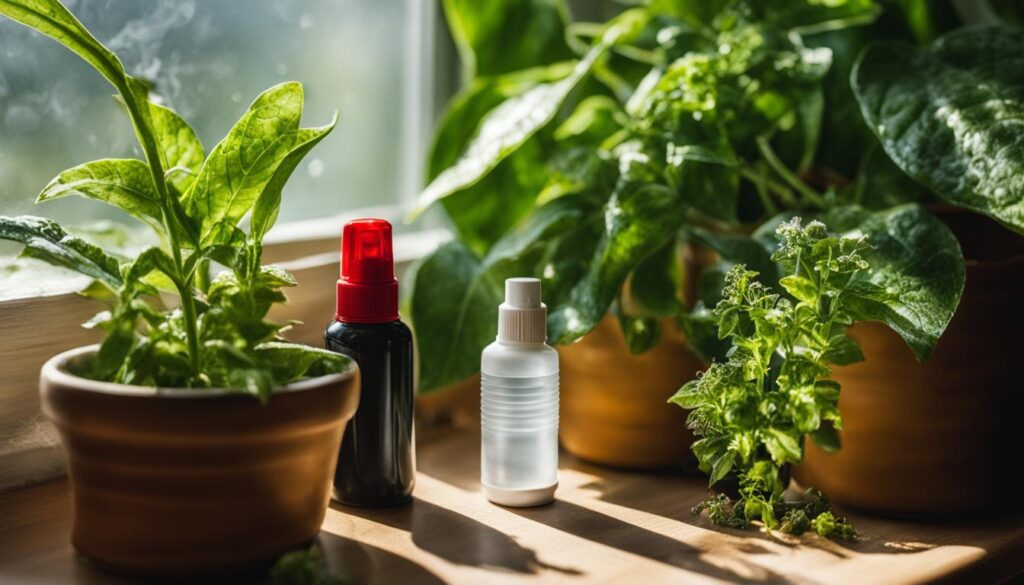
When it comes to eco-friendly gardening and zero waste bug control, pepper spray is a simple yet effective solution. Using ingredients readily available in your kitchen, you can create a natural pest repellent that will keep your indoor plants healthy and thriving.
Capsaicin, the compound found in peppers, acts as an irritant to many insects, making it an excellent deterrent for pests.
To make pepper spray, start by boiling 1/4 cup of pepper flakes in a cup of water. Once the mixture has cooled, strain away the flakes, leaving behind a concentrated liquid.
Transfer the liquid into a spray bottle and apply it to your plants, making sure to target the areas with the most pest activity. It’s important to spray at night to avoid harming the leaves under direct sunlight.
Pepper spray is a natural and chemical-free alternative to synthetic pesticides and insecticides. By utilizing this zero waste bug control method, you can keep your indoor plants pest-free while minimizing your environmental impact. Plus, it’s a cost-effective solution that can be easily made at home.
Benefits of Pepper Spray for Bug Control
- Effective against common pests
- Natural and chemical-free
- Readily available ingredients
- Zero waste and eco-friendly
- Cost-effective
Tips for Using Pepper Spray
- Test the spray on a small area of your plant before applying it to the entire plant to ensure that it doesn’t cause any damage.
- Reapply the spray as needed, especially after watering your plants or during periods of heavy rain.
- Store the pepper spray in a cool, dark place to maintain its effectiveness.
- Keep the spray out of reach of children and pets.
Banana Tea Fertilizer
As an advocate for sustainable gardening and zero waste practices, I’m always on the lookout for eco-friendly plant care solutions.
One effective and natural fertilizer option for indoor plants is banana tea. This homemade fertilizer is made by soaking banana peels in water, allowing the water to absorb the nutrients from the peels. After removing the peels, the leftover water can be used to nourish your house plants.
To make banana tea, simply place your banana peels in a container and cover them with water. Let the peels steep in the water for about a week, allowing the nutrients to infuse into the liquid.
After a week, remove the peels and dilute the banana tea with fresh water. You can then use this nutrient-rich solution to water your indoor plants, providing them with a natural source of potassium.
Using banana tea as a fertilizer offers several benefits. Firstly, it is a zero waste solution, utilizing food scraps that would otherwise be discarded.
Secondly, it provides a sustainable and eco-friendly alternative to synthetic fertilizers, reducing your environmental impact. Lastly, banana tea is a cost-effective option, as it can be made from items you likely already have in your kitchen.
Benefits of Banana Tea Fertilizer:
- Utilizes food scraps, reducing waste
- Provides a natural source of potassium for plants
- Eliminates the need for synthetic fertilizers
- Cost-effective and easy to make
By incorporating banana tea fertilizer into your indoor plant care routine, you can take a significant step towards zero waste gardening and sustainable plant care practices.
Embrace the power of natural and homemade fertilizers to promote healthy growth and contribute to a greener, more eco-friendly world.
Tea Leaves as Fertilizer
In sustainable gardening, finding natural and zero waste solutions for plant care is crucial. One eco-friendly and cost-effective option is to repurpose used tea leaves as a natural fertilizer for your indoor plants.
Tea leaves are rich in nutrients like nitrogen, potassium, and phosphorus, making them a valuable addition to your plant soil.
To use tea leaves as fertilizer, simply save your used tea leaves after brewing your morning cup. Allow the tea leaves to dry out completely, then crumble them into small pieces.
Mix the crumbled tea leaves into the soil around your plants, ensuring they are well incorporated. The tea leaves will slowly release nutrients into the soil, promoting healthy plant growth.
Using tea leaves as fertilizer not only reduces waste but also reduces the need for synthetic fertilizers. By opting for an eco-friendly plant care approach, you can support the health of your indoor plants and contribute to a more sustainable gardening practice.
Benefits of Using Tea Leaves as Fertilizer:
- Natural source of nutrients: Tea leaves contain essential nutrients like nitrogen, potassium, and phosphorus, which promote healthy plant growth.
- Zero waste solution: By repurposing used tea leaves, you can reduce waste and contribute to sustainable gardening practices.
- Cost-effective: Tea leaves are readily available and using them as fertilizer eliminates the need to purchase expensive synthetic fertilizers.
- Environmentally friendly: Choosing natural fertilizers like tea leaves helps minimize the use of chemicals and reduces the environmental impact of plant care.
How to Use Tea Leaves as Fertilizer:
- Save used tea leaves after brewing.
- Allow the tea leaves to dry completely.
- Crumble the dried tea leaves into small pieces.
- Incorporate the crumbled tea leaves into the soil around your indoor plants.
Epsom Salt as a Natural Plant Fertilizer
When it comes to sustainable gardening and zero waste fertilizer options, Epsom salt is a versatile and affordable choice.
Epsom salt, also known as magnesium sulfate, provides essential nutrients to plants and can help improve their overall health and growth. It is particularly beneficial for plants that require a magnesium boost, such as tomatoes, peppers, and roses.
To use Epsom salt as a fertilizer, simply dissolve a small amount in the water you use to water your plants. You can start with a teaspoon of Epsom salt per gallon of water and adjust the dosage based on your plants’ needs.
Avoid overapplying, as it can lead to salt buildup in the soil. It’s best to apply Epsom salt fertilizer every two to four weeks during the growing season.
Epsom salt not only provides essential nutrients to your plants but also offers several other benefits. It can help improve seed germination, enhance flower production, and prevent yellowing of leaves due to magnesium deficiency.
Also, Epsom salt can aid in the absorption of other nutrients from the soil, making them more readily available to plants.
Benefits of Using Epsom Salt as a Fertilizer:
- Provides essential magnesium and sulfate nutrients
- Improves overall plant health and growth
- Enhances flower production and seed germination
- Prevents yellowing of leaves due to magnesium deficiency
- Aids in the absorption of other nutrients from soil
By incorporating Epsom salt as a natural plant fertilizer, you can reduce your reliance on synthetic fertilizers and contribute to a more sustainable gardening routine.
It’s important to remember that while Epsom salt can be beneficial for many plants, it may not be suitable for all types. It’s always recommended to consult specific plant care guidelines and conduct a soil analysis to determine the specific nutrient needs of your plants.
Collecting Rainwater for Watering
When it comes to sustainable gardening and zero waste watering, collecting rainwater is an eco-friendly solution. By harnessing the power of nature, you can provide your indoor plants with a natural, chemical-free water source while reducing your reliance on treated tap water.
Collecting rainwater also helps prevent mineral buildup in the soil, promoting healthier plants in the long run.
To collect rainwater, you can set up a rain barrel or use other containers to capture the rainfall from your roof or outdoor area. Ensure that these containers have lids or covers to prevent the breeding of mosquitoes or other pests.
Once the rainwater is collected, allow it to sit for at least 24 hours to naturally eliminate any harmful contaminants before using it to water your indoor plants.
Rainwater can be especially beneficial for houseplants, as it is often softer than tap water and free from the chemicals commonly found in treated water.
By incorporating rainwater into your watering routine, you can take a step towards sustainable gardening and reduce your environmental impact.
Reusing Cooking Water for Watering
As a proponent of sustainable gardening and zero waste practices, I’m always on the lookout for ways to minimize my environmental impact. One simple yet effective method I’ve incorporated into my indoor plant care routine is reusing water from cooking.
Instead of letting cooking water go down the drain, I allow it to cool and repurpose it to water my plants. This not only helps conserve water but also provides a nutrient-rich boost for my indoor plants.
The water used to boil vegetables absorbs valuable nutrients during the cooking process, making it an excellent natural fertilizer. By reusing cooking water, I reduce waste and create a more eco-friendly plant care routine.
One important thing to note is that it’s essential to let the water cool completely before using it on your plants. Hot water could potentially harm the plant roots, so I always give it ample time to reach room temperature.
Once cooled, I use a watering can or a spray bottle to gently water my plants with the reused cooking water.
Reusing cooking water for watering is a simple yet impactful way to practice sustainable gardening and reduce waste.
By incorporating this zero waste technique into your plant care routine, you’ll not only be helping the environment but also providing your indoor plants with the nourishment they need to thrive.
FAQ
What are zero waste approaches in indoor plant care?
Zero waste approaches in indoor plant care involve implementing eco-friendly practices and waste reduction techniques to minimize your impact on the environment while nurturing your plants.
How can I reuse containers for repotting plants?
Instead of purchasing new pots and plastic containers, save and clean old ones to use when your plants need to be replanted. By reusing containers, you can minimize waste generation and save money on gardening supplies.
Why is regular removal of dead leaves important for plant care?
Regularly removing dead leaves helps your plants focus their energy on maintaining healthy foliage. Cutting off dead leaves with scissors instead of pulling them away also prevents them from rotting in the pot and allows for proper composting, minimizing waste.
How can I control bugs in indoor plants using soap spray?
Mix 1 teaspoon of mild soap, such as Castile soap, with 2 cups of water to create a soap spray. Spray this mixture on your plants once a week to get rid of common pests like beetles, whiteflies, mites, and aphids. Soap spray is readily available, and purchasing it in bulk or from zero waste shops with liquid soap refills can be a zero waste option.
What is neem oil and how can it be used for bug control in indoor plants?
Neem oil is a natural remedy that is biodegradable, non-toxic to pets, and effective against many common insects. To make a neem oil spray, mix 2 teaspoons of neem oil, 1 teaspoon of mild liquid soap, and 2 cups of water. Spray this mixture on the foliage, including the undersides of leaves, to treat infested plants or prevent bug infestations.
How can I make a pepper spray for bug control in indoor plants?
To make a pepper spray, boil 1/4 cup of pepper flakes in a cup of water, then let it cool and strain away the flakes. Spray the remaining liquid on your plants to drive away pests. It’s important to spray at night to avoid harming the leaves under direct sunlight. Pepper spray repels insects as capsaicin, a compound found in peppers, acts as an irritant to many insects.
What is banana tea fertilizer and how can I make it?
Banana tea is a homemade fertilizer made by soaking banana peels in water for a week. The water absorbs nutrients from the peels, and after the peels are removed, the leftover water can be used to fertilize house plants. Alternatively, you can simmer banana peels in boiling water for 2 hours and use the cooled water as fertilizer. Banana tea provides a natural source of potassium for your plants.
Can I reuse tea leaves as a fertilizer for indoor plants?
Yes, after brewing tea, save the used tea leaves and mix them into the soil for your plants. Tea leaves are rich in nutrients and can enhance the health and growth of your plants, reducing the need for synthetic fertilizers. Reusing tea leaves repurposes waste and reduces landfill contributions.
How can Epsom salt be used as a zero waste plant fertilizer?
Dilute a small amount of Epsom salt in the water you use to water your plants to give them a nutrient boost. Epsom salt provides magnesium and sulfate, which can improve plant growth. By using Epsom salt, you can minimize the use of synthetic fertilizers and reduce waste.
Is collecting rainwater a sustainable way to water indoor plants?
Yes, if you have access to an outdoor area and live in a region with sufficient rainfall, collecting rainwater can provide a natural and chemical-free water source for your plants. Using rainwater can help reduce your reliance on treated tap water, which may contain unnecessary chemicals for plant care. Rainwater collection also helps prevent mineral buildup in the soil, promoting healthier plants.
How can I reuse cooking water for watering indoor plants?
Instead of discarding the water used to boil vegetables, allow it to cool and use it to water your plants. This water contains nutrients absorbed from the vegetables and can provide an extra boost to your plants’ health. By reusing cooking water, you reduce waste and create a more sustainable indoor gardening routine.

